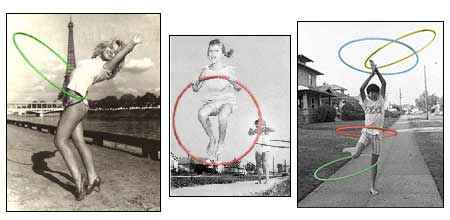Hula Hoop

Synopsis of Toy
In the abstract, some fads can look kind of silly. You’ve got a large ring made out of hard plastics, nothing fancy, nothing special, and suddenly every man, woman and child in America has to have one (at least one). Why? Who knows, who cares. Don’t try to make sense out of it. If you were there in 1958, you remember what it was like. If you weren’t, you may have learned to love the Hula Hoop, but you’ll never understand the madness.
The Hula Hoop is the standard by which all fads are measured. Somewhere inside that plastic ring lay the key to the hearts of a generation, and the Hula Hoop won those hearts like no toy before or since. Fads had certainly existed before—not three years earlier, Davy Crockett coonskin caps covered the heads of almost every boy on the playground—but the Hula Hoop was a new phenomenon. It wasn’t just for boys, it wasn’t just for girls… it wasn’t even just for kids. Everyone wanted one, and nearly everyone got one.
Hula Hoop-type toys had been around for years before 1958—centuries, in fact. Ancient Egyptian, Greek and Roman societies had similar hoops, and several other cultures had their own variations. The direct inspiration actually came from Australia, where a friend of Wham-O founders Arthur ‘Spud’ Melin and Richard Knerr spotted groups of schoolchildren exercising with bamboo rings, twirling them around their waists with constant hip gyrations. Melin and Knerr developed their own version, dubbed it “Hula Hoop” (after the hula-dance-like waist movements needed to keep it spinning), and set out to sell the things. Wham-O staged publicity events on playgrounds in Southern California, teaching kids how to twirl the hoops and giving out free Hula Hoops to build the buzz.
By the end of 1958, the buzz was a deafening roar. Wham-O sold 25 million Hula Hoops in four months at the height of the toy’s popularity, and several contests sprang up: “How many hoops can you twirl?” “How long can you keep them spinning?” and so on. Skilled Hula Hoopers could spin the rings not only around the waist, but on the arms and wrists, the legs and feet, and even the neck and head. And best of all, the hip gyrations made you look kind of like Elvis.
The Hula Hoop frenzy simmered back down to a buzz before too long—after all, with so many millions sold, most of the country already had a hoop or two—but Hula Hoops have remained a part of childhood from then until now. Whether for phys ed exercise or pure recreation, kids can still be found twisting the hoops that link them to what may be the biggest toy fad this planet has ever seen.
Release History of Toy
1958 - Hula HoopSub Categories of Toys
sportsother
